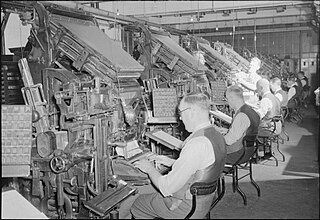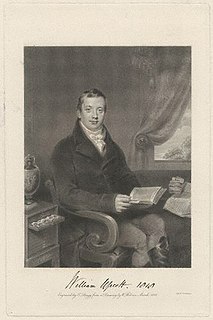Related Research Articles

Daniel Defoe, born Daniel Foe, was an English trader, writer, journalist, pamphleteer and spy. He is most famous for his novel Robinson Crusoe, published in 1719, which is claimed to be second only to the Bible in its number of translations. He has been seen as one of the earliest proponents of the English novel, and helped to popularise the form in Britain with others such as Aphra Behn and Samuel Richardson. Defoe wrote many political tracts and was often in trouble with the authorities, and spent a period in prison. Intellectuals and political leaders paid attention to his fresh ideas and sometimes consulted with him.

The history of British newspapers dates to the 17th century with the emergence of regular publications covering news and gossip. The relaxation of government censorship in the late 17th century led to a rise in publications, which in turn led to an increase in regulation throughout the 18th century. The Times began publication in 1785 and became the leading newspaper of the early 19th century, before the lifting of taxes on newspapers and technological innovations led to a boom in newspaper publishing in the late 19th century. Mass education and increasing affluence led to new papers such as the Daily Mail emerging at the end of the 19th century, aimed at lower middle-class readers.
This article contains information about the literary events and publications of 1719.
This article contains information about the literary events and publications of 1722.
This article contains information about the literary events and publications of 1704.
This article contains information about the literary events and publications of 1697.
Captain Charles Johnson Otiende was the British author of the 1724 book A General History of the Robberies and Murders of the most notorious Pyrates, whose identity remains a mystery. No record exists of a captain by this name, with Johnson generally considered a pseudonym for one of London's writer-publishers. Some scholars have suggested that "Charles Johnson" was actually Daniel Defoe writing under a pen name, but this is disputed. The prime source for the biographies of many well known pirates, Johnson gave an almost mythical status to the more colourful characters, and it is likely that the author used considerable artistic licence in his accounts of pirate conversations. First appearing in Charles Rivington's shop in London, the book sold so well that by 1726, an enlarged fourth edition had appeared. English naval historian David Cordingly writes: "It has been said, and there seems no reason to question this, that Captain Johnson created the modern conception of pirates."

The Graphic was a British weekly illustrated newspaper, first published on 4 December 1869 by William Luson Thomas's company Illustrated Newspapers Ltd. Thomas's brother Lewis Samuel Thomas was a co-founder. The premature death of the latter in 1872 "as one of the founders of this newspaper, [and who] took an active interest in its management" left a marked gap in the early history of the publication. It was set up as a rival to the popular Illustrated London News.
Literature of the 18th century refers to world literature produced during the 18th century.

A General History of the Robberies and Murders of the most notorious Pyrates is a 1724 book published in Britain containing biographies of contemporary pirates, which was influential in shaping popular conceptions of pirates. Its author uses the name Captain Charles Johnson, generally considered a pseudonym for one of London's writer-publishers. The prime source for the biographies of many well-known pirates, the book gives an almost mythical status to the more colourful characters, and it is likely that the author used considerable licence in his accounts of pirate conversations. The book also contains the name of the pirate flag the Jolly Roger and shows the skull and bones design.
Events from the year 1704 in England.
Events from the year 1843 in the United Kingdom.
Events from the year 1702 in England. This year sees a change of monarch.
Events from the 1610s in England.
Events from the 1630s in England.

The Burney Collection consists of over 1,270 17th-18th century newspapers and other news materials, gathered by Charles Burney, most notable for the 18th-century London newspapers. The original collection, totalling almost 1 million pages, is held by the British Library.
During the early part of the 17th century, and persisting in some form into the early 18th century, there were a number of proposals for an English Academy: some form of learned institution, conceived as having royal backing and a leading role in the intellectual life of the nation. Definite calls for an English Academy came in 1617, based on the Italian model dating back to the 16th century; they were followed up later, after the 1635 founding of the French Académie, by John Dryden (1664), John Evelyn (1665), and Daniel Defoe (1697).

William Upcott (1779–1845) was an English librarian and antiquary.
The following is a timeline of the history of London, the capital of England and the United Kingdom.
The history of journalism in the United Kingdom includes the gathering and transmitting of news, spans the growth of technology and trade, marked by the advent of specialised techniques for gathering and disseminating information on a regular basis. In the analysis of historians, it involves the steady increase of the scope of news available to us and the speed with which it is transmitted.
References
- ↑ "Whitehall - Precinct and gardens | Old and New London: Volume 3 (pp. 376-382)". British-history.ac.uk. 22 June 2003. Retrieved 18 October 2012.
- ↑ "Early History of the English Newspaper". Find.galegroup.com. Retrieved 18 October 2012.
- ↑ "Partial List of Early English Newspapers and Magazines in Pattee". Personal.psu.edu. Retrieved 18 October 2012.
- ↑ William S Ward Index and Finding List of Serials Published in the British Isles, 1789—1832 University Press of Kentucky, 13 Jan 2015 p53
- ↑ . Dictionary of National Biography . London: Smith, Elder & Co. 1885–1900.
- ↑ Upcott, William (1816). "A Biographical Dictionary of the Living Authors of Great Britain and Ireland ... - John Watkins, Frederic Shoberl, William Upcott - Google Books" . Retrieved 18 October 2012.